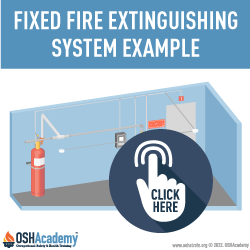Components of a Fixed System
Typical elements and components include:
- Discharge Nozzle: Discharge nozzles are used to disperse the extinguishing agent into the protected area.
- Piping: The piping system is used to transport the extinguishing agent (carbon dioxide, halon, argon, etc) from its storage container to the discharge nozzle.
- Control Panel: The control panel integrates all devices and displays their operational status and condition.
- Warning Alarm: Electronic devices that provide an audible or visual alarm when a hazard is detected. Each area protected by a fixed extinguishing system must have a distinctive alarm or signal which complies with 29 CFR 1910.165 to alert occupants that the system is discharging.
- Warning and Caution Signs: Hazard warning signs must be posted at the entrance to, and inside areas protected by fixed extinguishing systems.
- Fire Detectors: A device that detects fire and causes an alarm signal to be generated. Automatic detection devices sense the smoke, heat, or flames from a fire and initiate an alarm.
- Pull Station: A device that provides a way to manually discharge the fire extinguishing system. A manual discharge station is a device usually mounted on a wall near the emergency exit(s) which will automatically sound an alarm and release the extinguishing agent.
- Agent Storage Containers: The storage system discharges agent into the piping and through the discharge nozzles when activated by a manual or automatic device.
Knowledge Check Choose the best answer for the question.
3-4. What is used to transport the fixed system extinguishing agent from its storage container to the discharge nozzle?
You forgot to answer the question!

